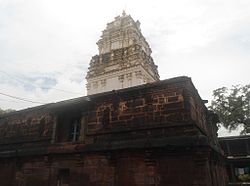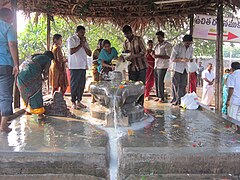Kumararama
It has been suggested that Chalukya Kumararama Bhimeswara Temple be merged into this article. (Discuss) Proposed since October 2020. |
This article needs additional citations for verification. (November 2013) |
| Kumararama Bhimesavara swami temple | |
|---|---|
| Religion | |
| Affiliation | Hinduism |
| District | East Godavari |
| Deity | Shiva, Bala Tripura sundari |
| Festivals | Maha Sivaratri |
| Location | |
| Location | Samarlakota |
| State | Andhra Pradesh |
| Country | India |
| Architecture | |
| Type | Chalukya and Kakatiya |
| Completed | 9th century |
| Temple(s) | One |
Kumararama or Bhimarama is one of the five Pancharama Kshetras that are sacred to the Hindu god Shiva. The temple is located in Samalkota of East Godavari district in the Indian state of Andhra Pradesh. The other four temples are Amararama at Amaravati(Dist. Guntur), Draksharama at Draksharama (Dist. East Godavari), Ksheerarama at Palakollu and Somarama at Bhimavaram(both in Dist. West Godavari).[1] It is one of the centrally protected monuments of national importance.[2]
Temple[edit]
The temple is 1 kilometer from Samarlakota City. The limestone Linga, installed in the shrine, is 16 feet tall that it rises from the pedestal on the ground floor and enters the second floor by piercing the roof, where the Rudrabhaga is worshipped. The temple has a mandapam that is supported by 100 pillars and is of great architectural importance. The temple has an Ekasila Nandi (A Bull carved from a single stone) guarding the Shiva Lingam at the entrance of the temple. The temple resembles the other Pancharama temple at Draksharama which is also called Bhimeswara Alayam. To the East side, there is a mantap called Koneti. Pushkarni (Koneru) lake can be seen here.
The construction of the temple was started in AD 892 and was completed during 922.here the Linga is made of limestone and appears white. From 1340–1466 during Musunuri Nayaks the temple was reconstructed. Kakatiya style of architecture is adopted by Musunuri Nayaks. Here the Goddess is also known as Bala Tripura Sundari.
Festivals[edit]
During November–December (Karthika and Margashira masam) months daily Abhisheka is carried out. There will be Utsavam (Kalyana Mahotsam) during February–March (Magha Bahula Ekadashi day) time. Till Maha Shivarathri grand celebrations in the temple can be seen. Temple timings are from morning 6.00am to 12.00 noon and after noon 4.00pm to 8.00pm. Additional places of interest around Samalkot include Draksharama, Annavaram, Thalupulamma Thalli and Rajahmundry.
photo gallery[edit]
References[edit]
- ↑ Talbot, Cynthia (2001). Precolonial India in Practice: Society, Region, and Identity in Medieval Andhra. Oxford University Press. p. 272. ISBN 978-0-19-513661-6. Retrieved 5 June 2017.
- ↑ "Centrally Protected Monuments". Archeological Survey of India. Archived from the original on 26 June 2017. Retrieved 27 May 2017.








